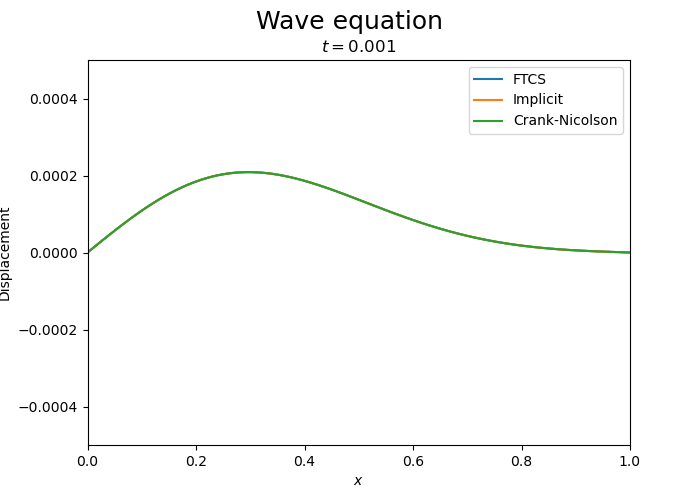Lecture Materials
Initial value problem: Wave equation#
Wave equation is an example of a second-order linear PDE describing the waves and standing wave fields. In one dimensions it reads
Since it is a 2nd order PDE, it is supplemented by initial conditions for both \(\phi(t=0,x)\) and \(\phi_t'(t=0,x)\):
The boundary conditions can be of either Dirichlet
or Neumann
forms.
We shall focus on the Dirichlet form.
Finite difference approach#
To deal with the second-order time derivative we denote
This way we are dealing with a system of first-order (in \(t\)) PDEs
To apply the finite difference method we first approximate the derivative \(\partial^2 \phi / \partial x^2\) by the lowest order central difference, just like for the heat equation,
To solve the PDEs numerically we apply the same procedure as for the heat equation, but for \(\phi(t,x)\) and \(\psi(t,x)\) simultaneously. Denoting \(\phi(t = nh,x = ka) = \phi^n_k\) and \(\psi(t = nh,x = ka) = \psi^n_k\) we get
FTCS scheme#
Implicit scheme#
Crank-Nicolson scheme#
FTCS scheme#
Let us simulate the wave equation using the FTCS scheme.
import numpy as np
# Single iteration of the FTCS scheme in the time direction
# h is the time step
# r = Dh/a^2 is the dimensionless parameter
def wave_FTCS_iteration(phi, psi, h, r):
N = len(phi) - 1
phinew = np.empty_like(phi)
psinew = np.empty_like(psi)
# Boundary conditions (here static Dirichlet)
phinew[0] = phi[0]
phinew[N] = phi[N]
psinew[0] = 0.
psinew[N] = 0.
# FTCS scheme
for i in range(1,N):
phinew[i] = phi[i] + h * psi[i]
psinew[i] = psi[i] + r * (phi[i+1] - 2 * phi[i] + phi[i-1])
return phinew, psinew
# Perform nsteps FTCS time iterations for the heat equation
# u0: the initial profile
# h: the size of the time step
# nsteps: number of time steps
# a: the spatial cell size
# D: the diffusion constant
def wave_FTCS_solve(phi0, psi0, h, nsteps, a, v = 1.):
phi = phi0.copy()
psi = psi0.copy()
r = h * v**2 / a**2
for i in range(nsteps):
phi, psi = wave_FTCS_iteration(phi, psi, h, r)
return phi, psi
Simulation
%%time
# Constants
L = 1 # Length
v = 0.1 # Wave propagation speed
N = 100 # Number of divisions in grid
a = L/N # Grid spacing
h = 1e-2 # Time-step
print("Solving the wave equation with FTCS scheme")
print("r = h*v^2/a^2 =",h*v**2/a**2)
# Initialize
phi = np.array([np.sin(k*np.pi/N) for k in range(N+1)])
psi = np.zeros([N+1],float)
# For the output
times = [ 1., 5., 10., 18.]
profiles = []
xk = [k*a for k in range(0,N+1)]
current_time = 0.
for time in times:
nsteps = round((time - current_time)/h)
phi, psi = wave_FTCS_solve(phi, psi, h, nsteps, a, v)
profiles.append(phi.copy())
current_time = time
import matplotlib.pyplot as plt
plt.title("Wave equation with FTCS scheme")
plt.xlabel('${x}$')
plt.ylabel('Displacement')
for i in range(len(times)):
plt.plot(xk,profiles[i],label="${t=}$" + str(times[i]))
plt.legend()
plt.show()
Solving the wave equation with FTCS scheme
r = h*v^2/a^2 = 1.0000000000000002
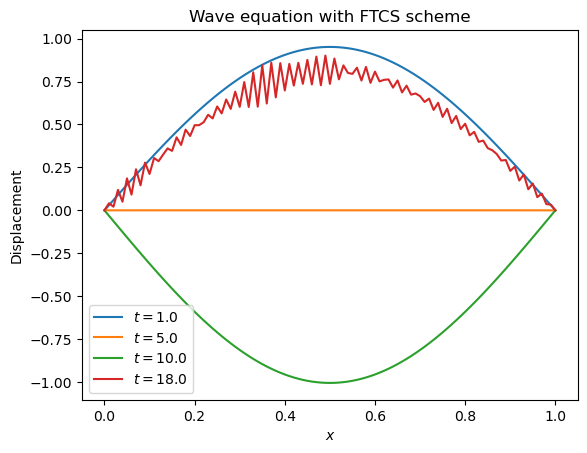
CPU times: user 942 ms, sys: 1.94 s, total: 2.89 s
Wall time: 507 ms
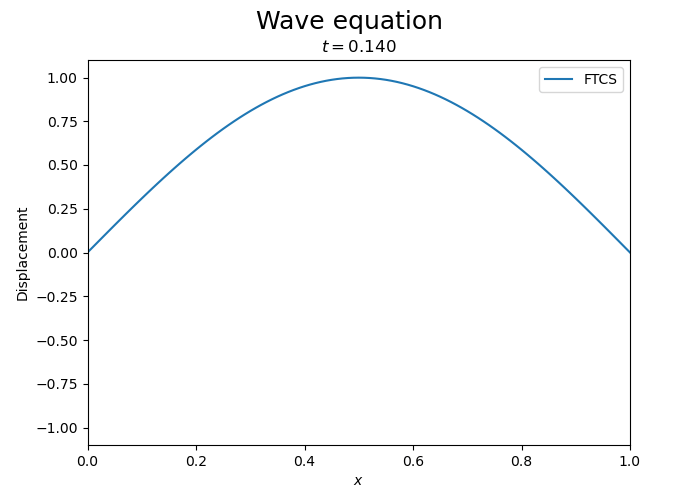
One can see the instability of the FTCS scheme for the wave equation. While initially the wave is propagating, the amplitude of the wave grows exponentially.
Implicit scheme#
As we learned earlier, implicit schemes are more stable than explicit ones. Let us use the implicit scheme for the time derivative in the wave equation:
Substituting the first equation into the second one gets the tridiagonal system of linear equations for \(\psi^{n+1}_k\): $\( -rh \psi^{n+1}_{k+1} + (1+2rh) \psi^{n+1}_k - rh \psi^{n+1}_{k-1} = \psi^n_k + r \, (\phi^{n}_{k+1} - 2\phi^{n}_k + \phi^{n}_{k-1}), \quad k = 1\ldots N-1 \)$
Once the tridiagonal system is solved, we can find \(\phi^{n+1}_k\) using the first equation.
import numpy as np
# Single iteration of the FTCS scheme in the time direction
# h is the time step
# r = Dh/a^2 is the dimensionless parameter
def wave_implicit_iteration(phi, psi, h, r):
N = len(phi) - 1
phinew = np.empty_like(phi)
psinew = np.empty_like(psi)
# Boundary conditions (here static Dirichlet)
phinew[0] = phi[0]
phinew[N] = phi[N]
psinew[0] = 0.
psinew[N] = 0.
# Tridiagonal system for psi
d = np.full(N-1, 1+2.*r*h)
ud = np.full(N-1, -r*h)
ld = np.full(N-1, -r*h)
v = np.array(psi[1:N] + r*phi[2:] - 2*r*phi[1:N] + r*phi[:-2])
v[0] += r * h * psi[0]
v[N-2] += r * h * psi[N]
psinew[1:N] = linsolve_tridiagonal(d,ld,ud,v)
# Final step for phi
for i in range(1,N):
phinew[i] = phi[i] + h * psinew[i]
return phinew, psinew
# Perform nsteps FTCS time iterations for the heat equation
# u0: the initial profile
# h: the size of the time step
# nsteps: number of time steps
# a: the spatial cell size
# D: the diffusion constant
def wave_implicit_solve(phi0, psi0, h, nsteps, a, v = 1.):
phi = phi0.copy()
psi = psi0.copy()
r = h * v**2 / a**2
for i in range(nsteps):
phi, psi = wave_implicit_iteration(phi, psi, h, r)
return phi, psi
Simulation
%%time
# Constants
L = 1 # Length
v = 0.1 # Wave propagation speed
N = 100 # Number of divisions in grid
a = L/N # Grid spacing
h = 1e-2 # Time-step
print("Solving the wave equation with FTCS scheme")
print("r = h*v^2/a^2 =",h*v**2/a**2)
# Initialize
phi = np.array([np.sin(k*np.pi/N) for k in range(N+1)])
psi = np.zeros([N+1],float)
# For the output
times = [ 1., 5., 10., 20., 190., 290.]
profiles = []
xk = [k*a for k in range(0,N+1)]
current_time = 0.
for time in times:
nsteps = round((time - current_time)/h)
phi, psi = wave_implicit_solve(phi, psi, h, nsteps, a, v)
profiles.append(phi.copy())
current_time = time
plt.title("Wave equation with implicit scheme")
plt.xlabel('${x}$')
plt.ylabel('Displacement')
for i in range(len(times)):
plt.plot(xk,profiles[i],label="${t=}$" + str(times[i]))
plt.legend()
plt.show()
Solving the wave equation with FTCS scheme
r = h*v^2/a^2 = 1.0000000000000002
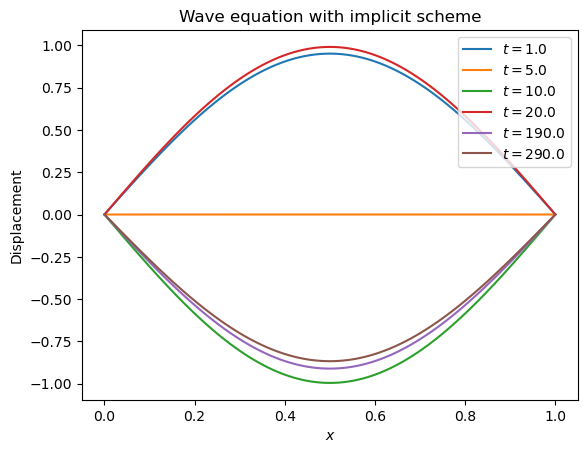
CPU times: user 4.17 s, sys: 7.51 ms, total: 4.18 s
Wall time: 3.74 s
One can see that the implicit scheme remains stable compared to the explicit one. However, the wave amplitude decreases with time, indicating damping. For this reason the implicit scheme is not a good choice for the wave equation over long times.
Crank-Nicolson scheme#
Substituting the first equation into the second one gets the tridiagonal system of linear equations for \(\psi^{n+1}_k\): $\( -rh \psi^{n+1}_{k+1} + 2(1+rh) \psi^{n+1}_k - rh \psi^{n+1}_{k-1} = 2 \psi^n_k + 2r \, (\phi^{n}_{k+1} - 2\phi^{n}_k + \phi^{n}_{k-1}) + rh \, (\psi^{n}_{k+1} - 2\psi^{n}_k + \psi^{n}_{k-1}), \quad k = 1\ldots N-1. \)$
This system can be solved using the same tridiagonal solver as before.
import numpy as np
# Single iteration of the FTCS scheme in the time direction
# h is the time step
# r = Dh/a^2 is the dimensionless parameter
def wave_crank_nicolson_iteration(phi, psi, h, r):
N = len(phi) - 1
phinew = np.empty_like(phi)
psinew = np.empty_like(psi)
# Boundary conditions (here static Dirichlet)
phinew[0] = phi[0]
phinew[N] = phi[N]
psinew[0] = 0.
psinew[N] = 0.
# Tridiagonal system for psi
d = np.full(N-1, 2*(1+r*h))
ud = np.full(N-1, -r*h)
ld = np.full(N-1, -r*h)
v = np.array(2*psi[1:N] + 2*r*phi[2:] - 4*r*phi[1:N] + 2*r*phi[:-2] \
+ r*h*psi[2:] - 2*r*h*psi[1:N] + r*h*psi[:-2])
v[0] += r * h * psi[0]
v[N-2] += r * h * psi[N]
psinew[1:N] = linsolve_tridiagonal(d,ld,ud,v)
# Final step for phi
for i in range(1,N):
phinew[i] = phi[i] + h * (psinew[i] + psi[i]) / 2
return phinew, psinew
# Perform nsteps FTCS time iterations for the heat equation
# u0: the initial profile
# h: the size of the time step
# nsteps: number of time steps
# a: the spatial cell size
# D: the diffusion constant
def wave_crank_nicolson_solve(phi0, psi0, h, nsteps, a, v = 1.):
phi = phi0.copy()
psi = psi0.copy()
r = h * v**2 / a**2
for i in range(nsteps):
phi, psi = wave_crank_nicolson_iteration(phi, psi, h, r)
return phi, psi
Simulation
%%time
# Constants
L = 1 # Length
v = 0.1 # Wave propagation speed
N = 100 # Number of divisions in grid
a = L/N # Grid spacing
h = 1e-2 # Time-step
print("Solving the wave equation with FTCS scheme")
print("r = h*v^2/a^2 =",h*v**2/a**2)
# Initialize
phi = np.array([np.sin(k*np.pi/N) for k in range(N+1)])
psi = np.zeros([N+1],float)
# For the output
times = [ 1., 5., 10., 20., 190., 290.]
profiles = []
xk = [k*a for k in range(0,N+1)]
current_time = 0.
for time in times:
nsteps = round((time - current_time)/h)
phi, psi = wave_crank_nicolson_solve(phi, psi, h, nsteps, a, v)
profiles.append(phi.copy())
current_time = time
plt.title("Wave equation with Crank-Nicolson scheme")
plt.xlabel('${x}$')
plt.ylabel('Displacement')
for i in range(len(times)):
plt.plot(xk,profiles[i],label="${t=}$" + str(times[i]))
plt.legend()
plt.show()
Solving the wave equation with FTCS scheme
r = h*v^2/a^2 = 1.0000000000000002
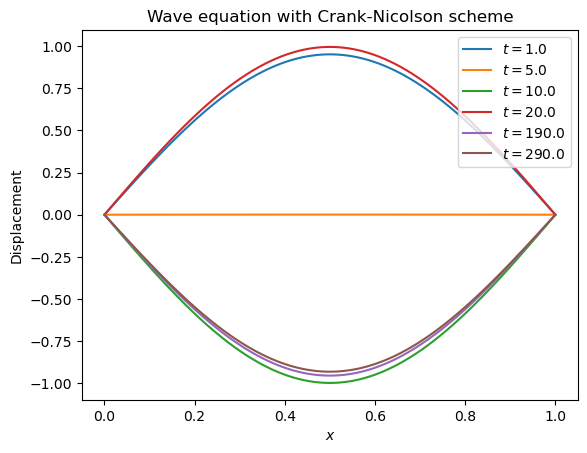
CPU times: user 4.66 s, sys: 7.03 ms, total: 4.66 s
Wall time: 4.18 s
This simulation appears to conserve the energy of the wave.
Let us compare the three schemes.
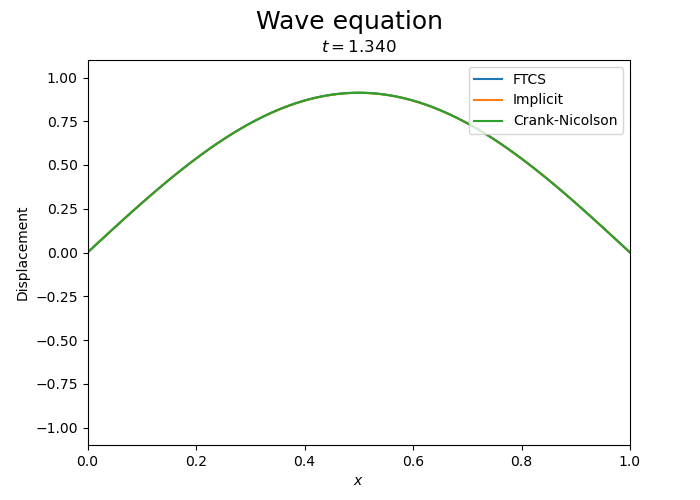
Pulse propagation#
Let us now consider corresponding to a pulse in the initial condition. The boundary conditions are Dirichlet: \(\phi(0,t) = \phi(L,t) = 0\). We expect the pulse to propagate to the right with speed \(v\) and then reflect back.
We take zero displacement in the initial condition and a Gaussian pulse in the initial velocity:
# Constants
L = 1 # Length
d = 0.1 # Initial profile
sig = 0.3 # Initial profile
v = 100. # Wave propagation speed
N = 100 # Number of divisions in grid
a = L/N # Grid spacing
h = 1e-6 # Time-step
# Initialize
phi1 = np.zeros([N+1],float)
xk = np.array([a*k for k in range(N+1)])
psi1 = xk * (L - xk) / L**2 * np.exp(-(xk-d)**2/2/sig**2)
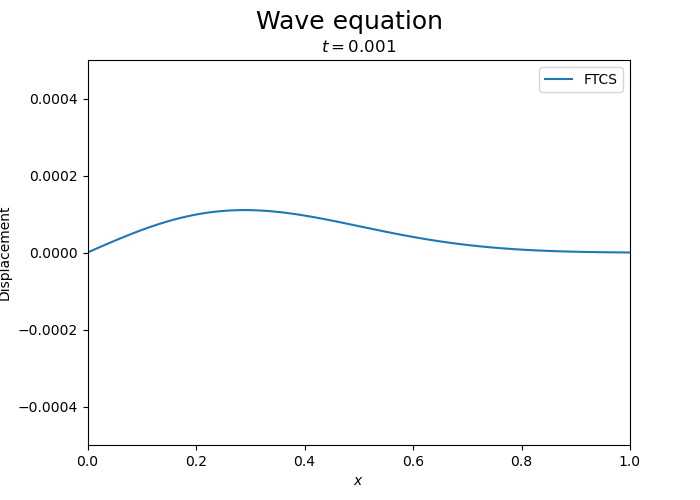
Compare with implicit and Crank-Nicolson
